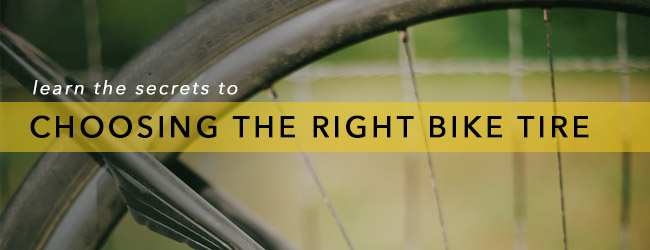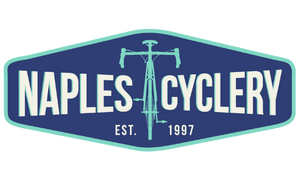
Are you a daily commuter who wants to avoid flats? The dirt enthusiast who lives for singletrack? Or an occasional cyclist looking for a comfortable ride? The information below will help you choose the right bicycle tire for your riding style.
Depending on the type of riding you do, you’ll want to choose the appropriate bike tire. Beyond the obvious—a tire suited to your rim size—you have a range of options.
No matter what type of rider you are, sharp tread edges are a must. When they're worn down to the point where you're getting lots of flats, your bike is handling poorly and/or the tread appears rounded or uneven, replace your tires to guarantee more fun and more safety.
Bike Tire Size
How do you know your current tire size? Easy—check the tire sidewall.
Mountain bike tires: On mountain bike tires you’ll see a number pairing that looks like 26x2.0. This is the bead-to-bead diameter (26") by the width (2"). (The bead is the edge of the tire that holds the tire onto the rim.)
A cross-country or all-mountain bike will have tires in the 1.8" to 2.4" width range. But freeride and downhill bikes, which are meant to withstand the abuse of drops and rock gardens, are equipped with tires ranging from 2.5" to 3.0" in width.
Road touring and racing tires: On road bike tires, you'll see a number pairing such as 700x23. The first number (700) is a size, which roughly corresponds to the diameter of the tire in millimeters. The second number (23) denotes the actual tire width in millimeters.
Exceptions include a few 650s (used on front wheels for faster acceleration and/or for smaller riders to decrease stand-over clearance) and the 27" size used on older bikes.
Most racers run 700 tires in widths ranging from 18 to 23mm — the narrowest options. Those who live for epic tours are more likely to be riding tires in widths ranging from 25 to 28mm for a bit more stability and comfort.
Cyclocross tires: These have small knobbies but are designed in a narrow-width 700 size to fit the geometry of cyclocross racing frames.
29ers: 29er mountain bikes run a wider, knobbier variation of the 700 tires used for cyclocross, but otherwise look like your typical mountain bike tire. 29ers are designed to roll more easily over technical trail sections and through mud and sand. Cornering and climbing traction may also be better due to their increased contact with the trail.
BMX tires usually come in a 20" diameter.
Bike Tire Tread
More tread typically means more grip—but also more rolling resistance. So you'll need to balance your need for speed with your desire for grip.
Slick bike tires: Designed for road, city/commuter, touring and mountain bikes, slicks appear almost smooth, with a barely perceptible tread pattern. Slicks are designed for smooth surfaces like asphalt, slickrock and groomed singletrack (with the width of the tire determining the best use). V-shaped grooves on some improve cornering on rain-soaked roads.
Semi-slick bike tires: These tires are designed with a smooth center, for minimal rolling resistance and faster acceleration, and aggressive treads on the side to help with cornering. They’re used for mostly smooth surfaces with some off-road applications.
Inverted tread tires: Tires designed with an inverted tread have more grip—and rolling resistance—than slicks, but less rolling resistance than knobbies. Use these tires if you suspect you might venture off asphalt or ride on roads with lots of ruts and potholes.
Knobby tires: Different knobby tread styles are designed for specific trail situations.
- Smaller knobs are faster and suitable for smooth singletrack.
- Taller knobs offer more grip in technical terrain like roots and rocks.
- Wider tires with sturdy paddle-like knobs are best for soft trail conditions.
- Knobs that are wider at the base will corner better on hardpack.
- Tires with tall, widely spaced knobs offer versatility in loose and hardpacked conditions.
- Tires designed for mud have widely-spaced knobbies so that mud sheds from the tire. (Otherwise you'll essentially be running slicks when mud gets packed between the knobs.)
Front- or Rear-Wheel Tire Treads
When shopping for mountain-bike tires, look for front- or rear-wheel specific treads.
Front tires are designed for front-end traction when cornering. Rear tires give optimal power transmission and rear wheel control.
Mount them with the tread facing the proper direction. To do so, check the sidewall for an arrow that points in the correct rotation direction.
Road tires are less complicated. Front- and rear-specific treads are often sold as sets. And because road tires grip the irregularities in pavement, you won't see as many tread variations, as you will with mountain-bike tires.
Bike Tire Valves
Presta valves are narrower and have built-in valve caps that you loosen to pump up the tire and tighten afterwards. Prestas are more typically seen on higher-end bikes, especially those designed for road riding. Do not use a Presta tube in a Schrader-size hole in your rim, as it will shift too much and possibly sever the valve.
Schrader valves are wider than Prestas, with a valve like those on car tires. These are most commonly found on inexpensive and mid-range bikes. Schraders won't even fit in a Presta-size hole. If your wheel has a Schrader-size hole, it is possible to get an adapter so that you can safely run Presta valves.
Bike Tire Features
Foldable Bike Tires
Instead of a wire bead (the edge of the tire that holds the tire onto the rim), these tires often have an aramid-fiber bead (such as Kevlar®). This makes them light and foldable for easy transport and storage. Foldable tires are available for both mountain bike and road riding. The downside is that they are usually more expensive.
Tubeless Bike Tires
These are popular with racers and high-performance riders. Depending on your weight and the terrain, you can run lower tire pressures—down to 20 psi (pounds per square inch)—for better traction without pinch flats. Plus, the ride tends to be smoother.
The cons? You can't use tire levers to ease the install process, and you may still want to carry a tube because fixing a tubeless flat is more complicated than on a conventional tire.
Keep in mind you need to have tire rims designed for this technology. More tubeless tires are available for mountain biking than road riding. They usually run $50 or more apiece.
Studded Bike Tires
Studded bike tires typically feature steel or aluminum studs with carbide pins to provide greater traction for riding on snowy or icy terrain.
Puncture-resistant Bike Tires
These tires won't feel as speedy as standard bike tires, but commuters, in particular, are likely to experience fewer flats. How? Many tire makers employ a durable belt of aramid fibers (such as the well-known Kevlar® brand) to resist punctures; others simply increase the tread thickness.
Soft or Hard Rubber Bike Tires
Most tires use primarily one type of rubber. Soft, sticky rubber is grippier while hard rubber is more durable. Most riders determine what type of tire to buy based on budget and performance requirements.
High-performance riders might want to consider dual-compound rubber tires. These feature a softer rubber on the outside that contacts the ground, and a harder rubber between the tread and the casing. The result? Better grip and better cornering in almost any terrain.
Bike Tire Thread Count Casing (TPI)
Thread counts have the most impact in road tires, where tire pressure is higher. A higher thread count casing makes the tire more supple and more resistant to punctures and makes it a little lighter.
Thread counts for a road bike tire start at 60 tpi (threads per inch) and go up to 320 tpi for higher-performance tires used in racing. Other tires have thread counts as low as 20 tpi.
